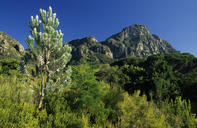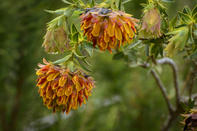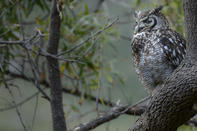Modern Tea-Room
Kirstenbosch was named after a German official of the Dutch East India Company named Johan Frederick Kirsten. Before he owned the garden, which was a woodcutter’s post at first, he was an official resident in Simon’s Town and owned considerable property in Constantia.

Henry Alexander, the Colonial Secretary of the British administration, became the garden’s owner in 1811. An individualist, he built a home there that included windowless bedrooms because he reasoned they would only be used at night. Unfortunately, the homestead burned down and in its place a tea-room was built, which also burned down. Eventually, a modern tea-room was built where the two previous establishments had been.
Gift to the People of South Africa

In 1811 as well, came the construction of an exquisite sunken bath in one of the hot springs of the Liesbeek River. The bath was built by Colonel Christopher Bird, assistant secretary to Henry Alexander, and the bath itself was built in the shape of a bird. A frequent visitor to the bath started a custom of throwing a coin into the bath and making a silent wish to Lady Anne Barnard. The bath became known as Lady Anne Barnard’s Bath in her memory.
When Henry Alexander died in 1895, Cecil John Rhodes bought Kirstenbosch. He then presented Kirstenbosch to the people of South Africa, intending that the site become a botanical garden. The suitability of the area was confirmed by Professor Harold Pearson in 1911 and in 1913 the area was proclaimed as Kirstenbosch National Botanical Gardens, with Professor Pearson serving as its first director.
Kirstenbosch National Botanical Gardens

Kirstenbosch covered an area of 497 ha. This included the overlooking slopes of Table Mountain’s back summit, going up to Maclear’s Beacon, the highest point at 1 066 m. Professor Pearson’s vision was to make Kirstenbosch a place where the indigenous plants of Southern Africa could be collected, preserved and studied.
Today the success of his labour can be clearly seen in the majesty of the Kirstenbosch Gardens which now covers 528 ha, 36 of which is cultivated and the rest of which is a protected area. The garden supports natural fynbos as well as forest and is home to a diverse population of indigenous animals, birds, reptiles, frogs and invertebrates. Pearson died in 1916 and his grave is situated in the garden with a fitting epitaph saying: “If ye seek his monument, look around you”.
Pearson was succeeded by Professor RH Compton who was the director of the garden from 1919 to 1953. Under his care the garden grew to become one of the principal botanical gardens of the world. The Botanical Society of South Africa’s headquarters are situated in the gardens. Nature-study instruction is given to parties of school children and the Compton Herbarium in the garden provides an ultimate authority in the identification and classification of the flora of Southern Africa.
 If you have only a day or two in Cape Town on your South African holiday, this self-drive route around the Cape to Cape Point covers the gre...
If you have only a day or two in Cape Town on your South African holiday, this self-drive route around the Cape to Cape Point covers the gre...